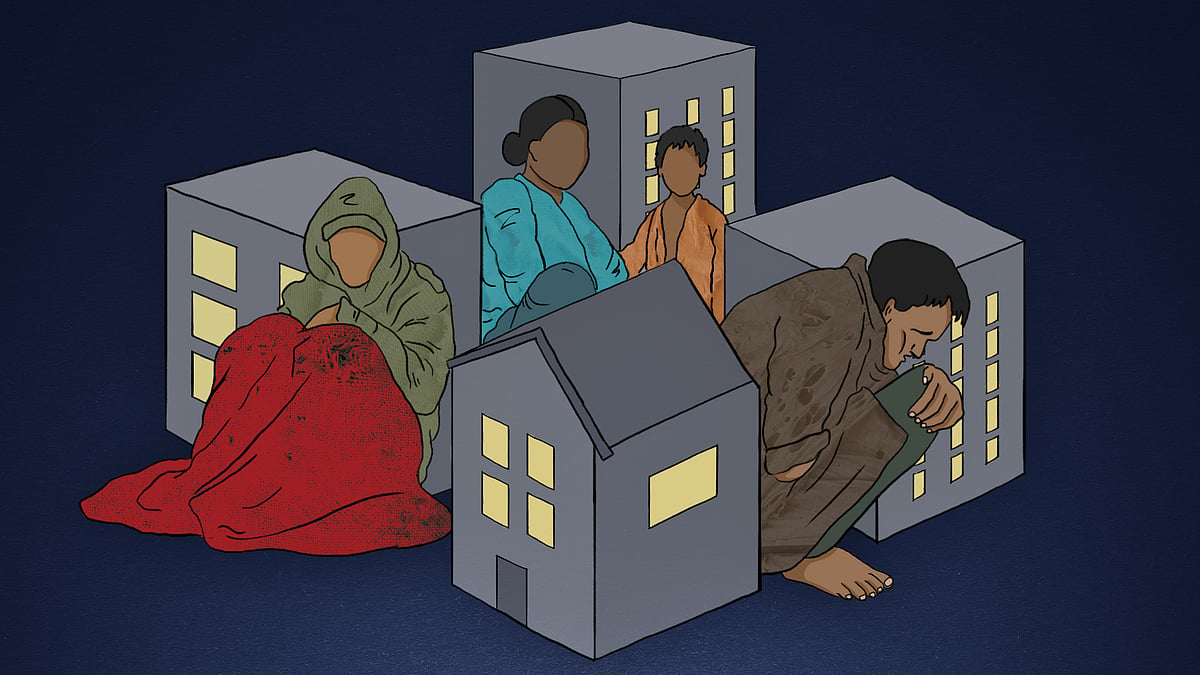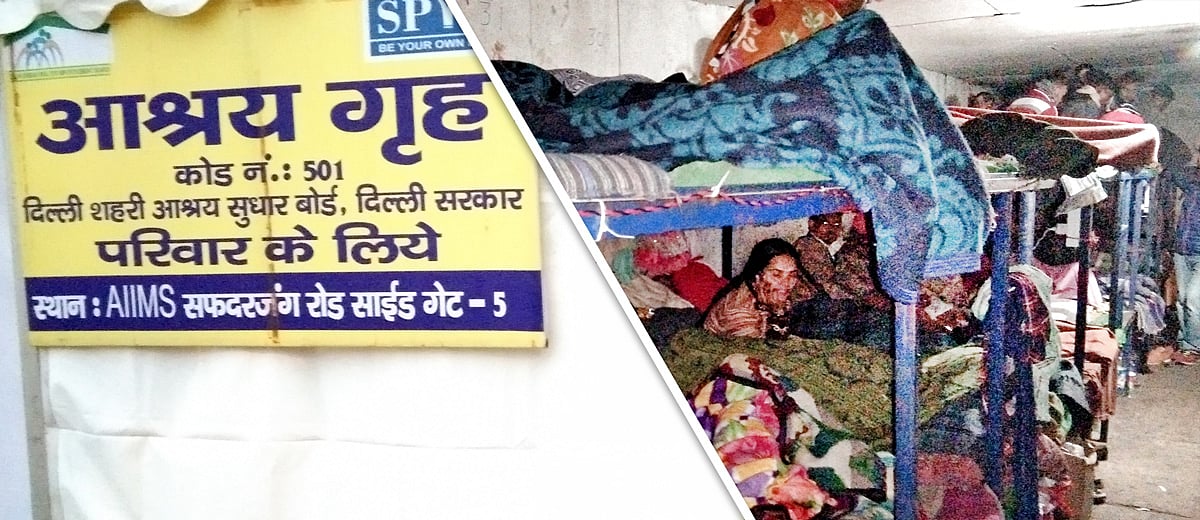‘This is all we can do’: In rain-hit Chennai, some homeless choose streets over shelters
Even as relief centres fill up amid red alert in Tamil Nadu capital, the homeless in Parry’s Corner say they have reasons to hold their ground.
“Our clothes are wet, the rain made it tough for us to cook, and we cannot afford to eat from hotels,” says Lakshmi, part of a group of flower vendors stringing together jasmines and roses in Parry’s Corner﹘an area housing the homeless for over 50 years in Chennai. But “this is all we can do”, the 32-year-old says, surrounded by utensils and bundles of clothes dotting the pavement.
Despite a "red alert" in Chennai for Thursday and heavy rain leading to 12 deaths in several districts of Tamil Nadu, homeless families in the area are reluctant to move to temporary relief centres set up by the state government or urban shelters run by the city’s civic agency.
The reasons, they claim, are several: the “lack” of urban shelters for families, and apprehensions about eviction and resettlement away from bustling commercial spaces.
Fears of eviction
The shadow of a resettlement involving 50 families in Egmore, another part of the city, last month looms large.
“Moving to temporary shelters is like falling in the trap of the Greater Chennai Corporation. Once we move out from here, the corporation would evict us permanently to the rehabilitation colonies,” says Lakshmi.

Following the 2015 floods, people residing on the banks of Chennai’s major waterways﹘Adyar and Cooum﹘have been evicted and relocated to resettlement colonies in Perumbakkam, Navalur and Gudapakkam.
A Dilip Kumar, field coordinator at the Information and Resource Centre for the Deprived Urban Communities, says “the resettlement has only worsened their woes. Those whose livelihood was in Chennai were relocated 20-40 km away without considering the fact that they have to shell out 30 percent of their income and time on the commute.”
An official of the Tamil Nadu Urban Habitat Development Board, who did not wish to be named, says, “It is an adverse situation. There is no space within the city to construct houses for the homeless. Even if they are moved to resettlement colonies, they sell it and come back to the streets to keep their livelihoods intact.”
However, D Prem Kumar, a resident of Kannagi Nagar who was relocated from Parry's Corner, says, “For many years, I stayed on the streets of Parry’s Corner while my family lived in Kannagi Nagar. I went home only during weekends.”
Kumar, who is fighting a heart disease, says he gets work at night when electrical supplies “usually” arrive.
Prabhakaran A, a labourer living in Parry’s Corner, says, “I earn Rs 200 a day. If we are allotted a house in one of the far-away resettlement colonies, I have to spend Rs 44 for the bus fare. I have to pay electricity bills and run the house too which is impossible.”
Asked why he can’t move to a temporary shelter, he says that “whatever we own, some utensils and a few clothes, is all here”. “When we leave, all these utensils will be stolen and we will have to start afresh.”

‘Lack’ of urban shelters for families
Nearly a kilometre away, at Evening Bazaar Road, the wide pavement of the memorial hall﹘a historical building used for film shoots﹘is home to 51 families, including of Rajeshwari R, a 40-year-old flower vendor. “We get good food whenever there is a shooting happening,” she says.
The homeless at Evening Bazaar do odd jobs such as selling masks and earphones in the bustling localities of Chennai Central, Fort Railway station and Rajiv Gandhi Government General Hospital.
“Rains only bring us trouble. I haven’t been able to sell flowers and I don’t have money to buy food for me and my family,” Rajeshwari says, sitting on a brick, gazing at the overcast sky. As it drizzles again on Tuesday evening, Rajeshwari rushes to the post office nearby for cover, with her two children following her. “My children are living on biscuits,” she says, adding that they have not had a square meal since Saturday due to the rain. She has not moved to the shelters run by the Greater Chennai Corporation as she is not aware of them, she says. But she would not have gone even if she was told as her “livelihood is here”, she points out.
The Greater Chennai Corporation maintains 55 shelters for homeless men, women, the elderly, persons with disabilites and transgender community, but these facilities are not designed to accommodate families. According to officials, the shelters currently house 2,000 inmates.
“Families can move to the nearby schools and marriage halls that have been converted to relief centres during calamities. There are more than 60 relief centres in the city currently and it’s an evolving number,” says D Sneha, deputy commissioner, Chennai Corporation.
Amid the rain, around 1,300 people are lodged in these relief centres in the city, officials said. Chennai was battered by heavy showers over the weekend﹘the heaviest since the 2015 floods﹘leading to widespread flooding in the city and its suburbs.
“Having teamed up with organisations and the Public Health Department, GCC runs separate shelters for men and women. We provide food and rehabilitation for these homeless people,” says G Saraswathi, assistant coordinator at the shelter programme.
However, for some like Lakshmi, these shelters are barely an option. “In the shelters, GCC provides skill training to the homeless and eventually relocation to the colonies. We have the skills of the local trade. Our livelihood might be bad now, but it is definitely better than no livelihood in these colonies,” she says.

‘No homeless policy’
“There are 9,084 homeless people in Chennai, according to the 2018 census by the GCC,” according to a policy paper titled Understanding disaster vulnerability of Chennai’s homeless and issued by Okapi Research and Advisory in collaboration with the Information and Resource Centre for the Deprived Urban Communities in May 2021.
“There is currently no homeless policy in the country,” it states. “The homeless shelters are being administered through the Shelters for Urban Homeless scheme under the Deen Dayal Antyodaya Yojana-National Urban Livelihoods Mission programme, which restricts the scope of the shelters since the programme is a livelihood mission and not a housing programme.”
Vanessa Peter, founder of IRCDUC, believes that “there is a need for evolving a comprehensive policy for the urban homeless in Tamil Nadu to facilitate convergence of various welfare schemes and coordination between different departments to safeguard the rights of those in street situations”.
During a hearing on a writ petition last month, a Madras High Court bench had urged the state government to frame a comprehensive policy for providing temporary and permanent accommodations to the landless and homeless in six months.

‘To live in a house is always a dream’
In Parry’s Corner, the public toilet is nearly half-a-kilometre away and costs Rs 5 each time. “At school, I enjoy the mid-day meals and also use the restroom without any discomfort,” says 13-year-old Sophia D. Many of the boys and girls in the area are enrolled in the GCC schools nearby.
Tamil Nadu Hindu religious and charitable endowments minister P K Sekar Babu had earlier promised to construct homes for the homeless in the vicinity of Parry’s Corner. “To live in a house has always been my dream. But I am not sure if I can trust the promises of politicians,” says Prabhakaran A.
 No homes for the homeless: How Maharashtra lags in implementing Centre’s urban shelter scheme
No homes for the homeless: How Maharashtra lags in implementing Centre’s urban shelter scheme Over 2,40,000 homeless, not even 300 night shelters: Delhi is struggling to save its rough sleepers from the harsh winter
Over 2,40,000 homeless, not even 300 night shelters: Delhi is struggling to save its rough sleepers from the harsh winter